Edit: I certainly missed gnuplot's intended way via option covariancevariables (apparently available since gnuplot 5.0). Ethan's answer is the way to go. I nevertheless leave my answer, with some modifications it might maybe be useful to extract something else from the fit output.
Maybe I missed it, but I am not aware that you can directly store the elements of the correlation matrix into variables, however, you can do it with some workaround.
You can set the output file for your fit results (check help set fit). The shortest output will be created with the option results. The results will be written to this file (actually, appended if the file already exists).
Example:
After 5 iterations the fit converged.
final sum of squares of residuals : 0.45
rel. change during last iteration : -3.96255e-10
degrees of freedom (FIT_NDF) : 1
rms of residuals (FIT_STDFIT) = sqrt(WSSR/ndf) : 0.67082
variance of residuals (reduced chisquare) = WSSR/ndf : 0.45
Final set of parameters Asymptotic Standard Error
======================= ==========================
a = 1.75 +/- 0.3354 (19.17%)
b = -2.65 +/- 1.704 (64.29%)
c = 1.75 +/- 1.867 (106.7%)
correlation matrix of the fit parameters:
a b c
a 1.000
b -0.984 1.000
c 0.898 -0.955 1.000
Now, you can read this file back into a datablock (check gnuplot: load datafile 1:1 into datablock) and extract the values from the last lines (here: 3), check help word and check real.
Script:
### get fit correlation matrix into variables
reset session
$Data <<EOD
1 1
2 3
3 10
4 19
EOD
f(x) = a*x**2 + b*x + c
myFitFILE = "SO71788523_fit.dat"
set fit results logfile myFitFILE
fit f(x) $Data u 1:2 via a,b,c
set key top left
set grid x,y
# load file 1:1 into datablock
FileToDatablock(f,d) = GPVAL_SYSNAME[1:7] eq "Windows" ? \
sprintf('< echo %s ^<^<EOD & type "%s"',d,f) : \
sprintf('< echo "\%s <<EOD" & cat "%s"',d,f) # Linux/MacOS
load FileToDatablock(myFitFILE,'$FIT')
# extract parameters into variables
N = 3 # number of parameters
getValue(p1,p2) = real(word($FIT[|$FIT|-N+p1],p2+1)) # extract value as floating point number
aa = getValue(1,1)
ba = getValue(2,1)
bb = getValue(2,2)
ca = getValue(3,1)
cb = getValue(3,2)
cc = getValue(3,3)
set label 1 at graph 0.1,graph 0.8 \
sprintf("Correlation matrix:\naa: %g\nba: %g\nbb: %g\nca: %g\ncb: %g\ncc: %g",aa,ba,bb,ca,cb,cc)
plot $Data u 1:2 w lp pt 7 lc "red", \
f(x) w l lc "blue" title sprintf("fit: a=%g, b=%g, c=%g",a,b,c)
### end of script
Result:

